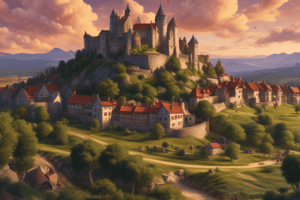Podcast
Questions and Answers
Which of the following best describes the Early Middle Ages?
Which of the following best describes the Early Middle Ages?
- A period of significant scientific advancement and exploration
- A phase dominated by strong centralized governments and trade
- An era marked by widespread literacy and philosophical growth
- A time characterized by societal instability and decline in urban life (correct)
What is a key feature of the High Middle Ages?
What is a key feature of the High Middle Ages?
- Decline of the Catholic Church's influence in daily life
- Development of complex trade networks and urbanization (correct)
- Increased feudal conflicts and wars between kingdoms
- Predominance of nomadic lifestyles and tribal governance
Which statement accurately reflects the Late Middle Ages?
Which statement accurately reflects the Late Middle Ages?
- There were no significant conflicts or crises during this period.
- It was a time of total peace among European nations.
- Society was fully united under a global empire focused on expansion.
- This era experienced the beginning of the Renaissance and increased cultural awareness. (correct)
What was a significant impact of the Dark Ages on European society?
What was a significant impact of the Dark Ages on European society?
Which of the following cultural shifts occurred during the Dark Ages?
Which of the following cultural shifts occurred during the Dark Ages?
Flashcards are hidden until you start studying
Study Notes
Early Middle Ages
- Marked by the fall of the Western Roman Empire around 476 AD, leading to a fragmented Europe.
- The establishment of feudalism as the dominant social and political structure.
- Significant population decline due to invasions, plagues, and migration.
- Rise of the Catholic Church as a unifying force and center of influence.
- Cultural stagnation and loss of classical knowledge, often referred to as the "Dark Ages."
- Increased invasions from groups such as the Vikings, Magyars, and Saracens, contributing to instability.
- Development of local economies and agriculture, focusing on manorialism.
High Middle Ages
- Characterized by the growth of towns and the revival of trade, leading to economic development.
- Emergence of universities and the rise of scholasticism, blending theology with philosophy.
- Expansion of the Catholic Church's power, including the influence of the papacy.
- Development of chivalry and the knightly class, promoting ideals of knighthood and courtly behavior.
- Notable events include the Crusades, which aimed to reclaim the Holy Land and increased cultural exchanges.
- Architectural advancements, epitomized by Gothic cathedrals, showcasing verticality and light.
- Heightened conflict between kingdoms, leading to wars such as the Hundred Years' War.
Late Middle Ages
- Marked by significant social upheaval, including the Black Death in the 14th century, which decimated populations.
- Decline of feudalism as labor shortages led to increased wages and power for the peasantry.
- Rise of nation-states, as monarchies consolidated power, leading to centralized governments.
- Cultural flourishing during the Renaissance began to emerge towards the end of this period.
- The Great Schism (1378-1417) fractured the Catholic Church, causing political and religious turmoil.
Studying That Suits You
Use AI to generate personalized quizzes and flashcards to suit your learning preferences.




